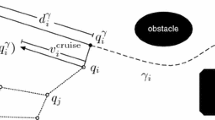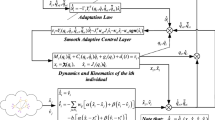Abstract
We present a control framework for achieving encirclement of a target moving in 3D using a multi-robot system. Three variations of a basic control strategy are proposed for different versions of the encirclement problem, and their effectiveness is formally established. An extension ensuring maintenance of a safe inter-robot distance is also discussed. The proposed framework is fully decentralized and only requires local communication among robots; in particular, each robot locally estimates all the relevant global quantities. We validate the proposed strategy through simulations on kinematic point robots and quadrotor UAVs, as well as experiments on differential-drive wheeled mobile robots.











Similar content being viewed by others
Notes
Note that matrix \(J_i\) is invertible whenever \(\phi _i\) is defined, i.e., unless the ith robot is exactly above the target. This zero-measure case represents a purely theoretical problem, especially considering the presence of noise in the measurements.
It is a differently weighted Laplacian of the undirected ring.
Note that the first-order derivative \(\dot{\varvec{p}}_i=\varvec{u}_i\) is directly given by the general expression (22), whereas the second-order derivative \(\ddot{\varvec{p}}_i(t)\) is numerically computed.
References
Antonelli, G., Arrichiello, F., & Chiaverini, S. (2008). The entrapment/escorting mission: An experimental study using a multirobot system. IEEE Robotics & Automation Magazine, 15(1), 22–29.
Ceccarelli, N., Di Marco, M., Garulli, A., & Giannitrapani, A. (2008). Collective circular motion of multi-vehicle systems. Automatica, 44(12), 3025–3035.
Censi, A., Franchi, A., Marchionni, L., & Oriolo, G. (2013). Simultaneous maximum-likelihood calibration of odometry and sensor parameters. IEEE Transactions on Robotics, 29(2), 475–492.
Fliess, M., Lévine, J., Martin, P., & Rouchon, P. (1995). Flatness and defect of nonlinear systems: Introductory theory and examples. International Journal of Control, 61(6), 1327–1361.
Franchi, A., Oriolo, G., & Stegagno, P. (2010a). Probabilistic mutual localization in multi-agent systems from anonymous position measures. In 49th IEEE Conference on Decision and Control (pp.6534–6540). Atlanta, GA.
Franchi, A., Stegagno, P., Di Rocco, M., & Oriolo, G. (2010b). Distributed target localization and encirclement with a multi-robot system. In 7th IFAC Symposium on Intelligent Autonomous Vehicles, Lecce, Italy.
Franchi, A., Secchi, C., Ryll, M., Bülthoff, H. H., & Robuffo Giordano, P. (2012). Shared control: Balancing autonomy and human assistance with a group of quadrotor UAVs. IEEE Robotics & Automation Magazine, Special Issue on Aerial Robotics and the Quadrotor Platform, 19(3), 57–68.
Franchi, A., Oriolo, G., & Stegagno, P. (2013). Mutual localization in multi-robot systems using anonymous relative measurements. The International Journal of Robotics Research, 32(11), 1302–1322.
Gazi, V., & Passino, K. M. (2002). Stability analysis of social foraging swarms: combined effects of attractant/repellent profiles. 41th IEEE Conference on Decision and Control (pp. 2848–2853). Las Vegas, NV.
Gonçalves, M. M., Pimenta, L. C. A., & Pereira, G. A. S. (2011). Coverage of curves in 3D with swarms of nonholonomic aerial robots. In 18th IFAC World Congress (pp. 10367–10372). Milano, Italy.
Grabe, V., Riedel, M. Bülthoff, H. H., Robuffo Giordano, P., & Franchi, A. (2013). The TeleKyb framework for a modular and extendible ROS-based quadrotor control. In 6th European Conference on Mobile Robots (pp. 19–25). Barcelona, Spain.
Gray, R. M. (2006). Toeplitz and circulant matrices: A review. Foundations and Trends in Technology: Now Publishers. ISBN 9781933019239.
Gui, B., Dai, L., & Cimini, L. J. (2009). Routing strategies in multihop cooperative networks. IEEE Transaction on Wireless Communications, 8(2), 843–855.
Gurvits, L., Shorten, R., & Mason, O. (2007). On the stability of switched positive linear systems. IEEE Transaction on Automatic Control, 52(6), 1099–1103.
Hara, S., Kim, T. H., Hori, Y. (2008). Distributed formation control for target-enclosing operations based on a cyclic pursuit strategy. In 17th IFAC World Congress (pp. 6602–6607). Seoul, South Korea.
Hsieh, M. A., Kumar, V., & Chaimowicz, L. (2008). Decentralized controllers for shape generation with robotic swarms. Robotica, 26(5), 691–701.
Isidori, A. (1995). Nonlinear control systems (3rd ed.). New York: Springer. ISBN 3540199160.
Jönsson, U. T., & Kao, C. Y. (2010). Consensus of heterogeneous linear agents applied to a formation control problem. 49th IEEE Conference on Decision and Control (pp. 743–1546). Atlanta, GA
Kawakami, H., & Namerikawa, T. (2009). Cooperative target-capturing strategy for multi-vehicle systems with dynamic network topology. In 2009 American Control Conference (pp. 635–640). St. Louis, MO.
Lächele, J., Franchi, A., Bülthoff, H. H., & Robuffo Giordano, P. (2012). SwarmSimX: Real-time simulation environment for multi-robot systems. In I. Noda, N. Ando, D. Brugali, and J.J. Kuffner (Ed.), 3rd International Conference on Simulation, Modeling, and Programming for Autonomous Robots, vol. 7628 of Lecture Notes in Computer Science (pp. 375–387). Springer, New York.
Lan, Y., & Lin, Z. (2010). A distributed reconfigurable control law for escorting and patrolling missions using teams of unicycles. 49th IEEE Conference on Decision and Control (pp. 5456–5461). Atlanta, GA.
Lee, D. J., Franchi, A., Son, H. I., Bülthoff, H. H., & Robuffo, P. (2013). Giordano. Semi-autonomous haptic teleoperation control architecture of multiple unmanned aerial vehicles. IEEE/ASME Trans. on Mechatronics, Focused Section on Aerospace. Mechatronics, 18(4), 1334–1345.
Leonard, N. E., & Fiorelli, E. (2001). Virtual leaders, artificial potentials and coordinated control of groups. 40th IEEE Conference on Decision and Control (pp. 2968–2973). Orlando, FL.
Lin, Z., Francis, B., & Maggiore, M. (2005). Necessary and sufficient graphical conditions for formation control of unicycles. IEEE Transaction on Automatic Control, 50(1), 121–127.
Mas, I., Li, S., Acain, J., Kitts, C. (2009). Entrapment/escorting and patrolling missions in multi-robot cluster space control. In 2009 IEEE/RSJ International Conference on Intelligent Robots and Systems (pp. 5855–5861). St. Louis, MO.
Mellish, R., & Paley, D. (2010). Backstepping control design for motion coordination of self-propelled vehicles. 49th IEEE Conference on Decision and Control (pp. 5468–5473). Atlanta, GA.
Mistler, V., Benallegue, A., & M’Sirdi, N. K. (2001). Exact linearization and noninteracting control of a 4 rotors helicopter via dynamic feedback. In 10th IEEE International Symposium on Robots and Human Interactive Communications (pp. 586–593). Bordeaux, Paris, France.
Moreau, L. (2005). Stability of multiagent systems with time-dependent communication links. IEEE Transaction on Automatic Control, 50(2), 169–182.
Moshtagh, N., Michael, N., Jadbabaie, A., & Daniilidis, K. (2009). Vision-based, distributed control laws for motion coordination of nonholonomic robots. IEEE Transaction on Robotics, 25(4), 851–860.
Van Nieuwstadt, M. J., & Murray, R. M. (1998). Real-time trajectory generation for differentially flat systems. International Journal on Robust and Nonlinear Control, 8, 995–1020.
Olfati-Saber, R., & Murray, R. M. (2004). Consensus problems in networks of agents with switching topology and time-delays. IEEE Transaction on Automatic Control, 49(9), 1520–1533.
Oriolo, G., De Luca, A., & Vendittelli, M. (2002). WMR control via dynamic feedback linearization: Design, implementation, and experimental validation. IEEE Transaction on Control Systems Technology, 10(6), 835–852.
Pavone, M., & Frazzoli, E. (2007). Decentralized policies for geometric pattern formation. In 2007 American Control Conference (pp. 3949–3954). New York, NY.
Ren, W. (2007a). Consensus strategies for cooperative control of vehicle formations. IET Control Theory & Applications, 1(2), 505–512.
Ren, W. (2007b). Multi-vehicle consensus with a time-varying reference state. Systems & Control Letters, 56(7–8), 474–483.
Sabattini, L., Secchi, C., Fantuzzi, C., & de Macedo Possamai, D. (2010). Tracking of closed-curve trajectories for multi-robot systems. In 2010 IEEE/RSJ International Conference on Intelligent Robots and Systems (pp. 6089–6094). Taipei, Taiwan.
Sabattini, L., Secchi, C., & Fantuzzi, C. (2013). Closed-curve path tracking for decentralized systems of multiple mobile robots. Journal of Intelligent & Robotics Systems, 71(1), 109–123.
Sadowska, Kostic, D., Van de Wouw, N., Huijberts, H., & Nijmeijer, H. (2012). Distributed formation control of unicycle robots. In 2012 IEEE International Conference on Robotics and Automation (pp. 1564–1569). St. Paul, MN.
Sepulchre, R., Paley, D. A., & Leonard, N. E. (2007). Stabilization of planar collective motion: All-to-all communication. IEEE Transaction on Automatic Control, 52(5), 811–824.
Sepulchre, R., Paley, D. A., & Leonard, N. E. (2008). Stabilization of planar collective motion with limited communication. IEEE Transaction on Automatic Control, 53(3), 706–719.
Shames, I., Fidan, B., & Anderson, B. D. O. (2010). Close target reconnaissance with guaranteed collision avoidance. International Journal on Robust and Nonlinear Control.
Turpin, M., Michael, N., & Kumar, V. (2012). Decentralized formation control with variable shapes for aerial robots. In 2012 IEEE International Conference on Robotics and Automation (pp. 23–30). St. Paul, MN.
Author information
Authors and Affiliations
Corresponding author
Electronic supplementary material
Below is the link to the electronic supplementary material.
Rights and permissions
About this article
Cite this article
Franchi, A., Stegagno, P. & Oriolo, G. Decentralized multi-robot encirclement of a 3D target with guaranteed collision avoidance. Auton Robot 40, 245–265 (2016). https://doi.org/10.1007/s10514-015-9450-3
Received:
Accepted:
Published:
Issue Date:
DOI: https://doi.org/10.1007/s10514-015-9450-3




